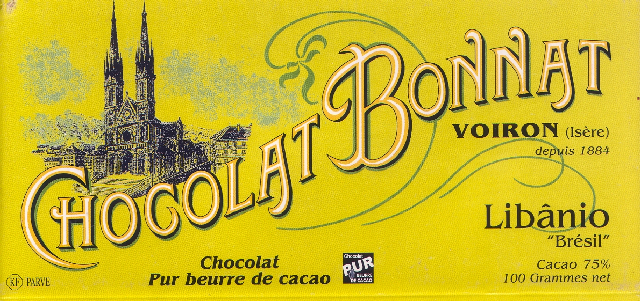
Impact
Appearance 3.9 / 5
| Color: | browned down into an orange-umber |
| Surface: | minor scuffing / grease splatter |
| Temper: | soft sheen |
| Snap: | clicks right for 75% |
Aroma 7.8 / 10
G-R-E-E-N: banana leaves, tobacco leaf & rubber sheath verdant cocoa & coffee berry
Mouthfeel 13.1 / 15
| Texture: | cushioned butter pad |
| Melt: | spongey |
Flavor 38.7 / 50
quick chocolate attack w/ a deflected red counter (pitanga cherry) -> bright coffee -> carob grounds the progression some -> lite stringent white (methyl benzoate / feijoa) -> coffee re-asserts for the finish -> rubber bands in the aft-shaft
Quality 14.2 / 20
Bonnat going out of his way to source the... well, in this case, the lackluster stuff. Nothing really to suspect over-heating the frying pan or over-conching the unit either. Just a regular cocoa from the M. Libânio Agrícola company – started in 1920 by the Libânio brothers, a pair of investment bankers lending credit to landholders around the Bahia, Brazil area where BR 101 intersects BA 250. 13 farms supporting a small association (100 families) including the rather widely-recognized Fazenda Venturosa, Bahia Cocoa Bean Co.
All together they tend to 600 hectares or so of cocoa among a 2,000 hectare tract of preserved Mata Atlantica (+ more for cattle grazing & rubber tapping) & cultivate 30+ clonal cacáo varieties which make any classification a taxing nightmare, be it Amazon, “Forastero”, “Trinitario” or a raft of others (Scavina, Cruzeiro do Sul, Ocumare, Chuao, Playa Alta, Silécia, Morona) handed out by CEPLAC (the Executive Planning Commission of Cocoa Farming) in conjunction with CIRAD (France), Mars candy bars (USA), the Universidade de São Paulo (Brazil), the Technological Institute of Sustenance’s - ITAL (São Paulo-Brazil), the Universidade de Santa Cruz (Bahia-Brazil). In other words, the usual int’l consortium sprinkling super seeds & hybrids all across the globe designed for disease resitence, drought tolerance & high productivity yields with flavor an after-thought.
In Brazil’s case, their efforts aim to thwart the dreaded Witches Broom disease that decimated Bahia in 1989 from, some accuse, an act of bio-terrorism by one large stakeholder against another.
M. Libânio lays claim to rigorous protocols. Each “break” of pods, split open on the orchards then scooped out to form an allotment of wet beans, is sorted, tagged & numbered for traceability; 5-7 days in cascading wooden box fermentation; another 7 – 10 days for native drying or sometimes in mobile greenhouses.
They also tout their personal touch & how everyone enjoys the work. Hmmm, really? Cacáo harvesting stands up to be a back-breaking bitch.
Whether Libânio actually lives up to its creed of peace, love & harmony among the community & environment requires a visit on the order of what Cristian Melo wrote about Ecuador. In a nib, it’s complicated.
At a minimum M. Libânio says the right things & sounds responsible at least in rhetoric (i.e., sustainability, organic, worker’s partnerships & co-determination, etc.). Given the level of discussion on their website as well as on the phone, particularly in the technical aspects if less so with the social dynamics, suggest that they’re true to their word.
All in line with an industry trying to self-correct & reform the way it conducts business.
Let’s hope they take care of matters fast to focus next on hi-flavor. Either that or someone please add vanilla to the mix.
ING: cocoa mass, cacáo butter, sugar
Reviewed January 2011
All together they tend to 600 hectares or so of cocoa among a 2,000 hectare tract of preserved Mata Atlantica (+ more for cattle grazing & rubber tapping) & cultivate 30+ clonal cacáo varieties which make any classification a taxing nightmare, be it Amazon, “Forastero”, “Trinitario” or a raft of others (Scavina, Cruzeiro do Sul, Ocumare, Chuao, Playa Alta, Silécia, Morona) handed out by CEPLAC (the Executive Planning Commission of Cocoa Farming) in conjunction with CIRAD (France), Mars candy bars (USA), the Universidade de São Paulo (Brazil), the Technological Institute of Sustenance’s - ITAL (São Paulo-Brazil), the Universidade de Santa Cruz (Bahia-Brazil). In other words, the usual int’l consortium sprinkling super seeds & hybrids all across the globe designed for disease resitence, drought tolerance & high productivity yields with flavor an after-thought.
In Brazil’s case, their efforts aim to thwart the dreaded Witches Broom disease that decimated Bahia in 1989 from, some accuse, an act of bio-terrorism by one large stakeholder against another.
M. Libânio lays claim to rigorous protocols. Each “break” of pods, split open on the orchards then scooped out to form an allotment of wet beans, is sorted, tagged & numbered for traceability; 5-7 days in cascading wooden box fermentation; another 7 – 10 days for native drying or sometimes in mobile greenhouses.
They also tout their personal touch & how everyone enjoys the work. Hmmm, really? Cacáo harvesting stands up to be a back-breaking bitch.
Whether Libânio actually lives up to its creed of peace, love & harmony among the community & environment requires a visit on the order of what Cristian Melo wrote about Ecuador. In a nib, it’s complicated.
At a minimum M. Libânio says the right things & sounds responsible at least in rhetoric (i.e., sustainability, organic, worker’s partnerships & co-determination, etc.). Given the level of discussion on their website as well as on the phone, particularly in the technical aspects if less so with the social dynamics, suggest that they’re true to their word.
All in line with an industry trying to self-correct & reform the way it conducts business.
Let’s hope they take care of matters fast to focus next on hi-flavor. Either that or someone please add vanilla to the mix.
ING: cocoa mass, cacáo butter, sugar
Reviewed January 2011




